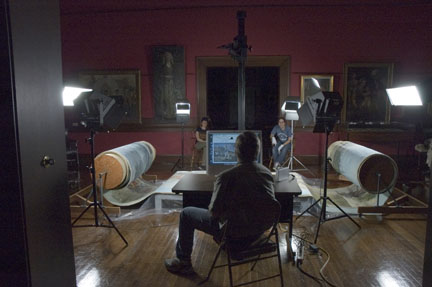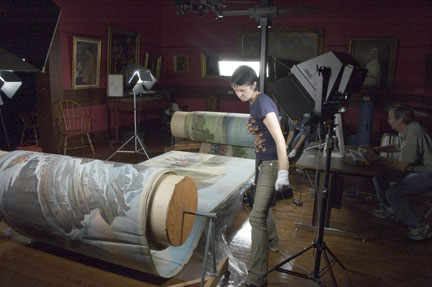
|
September 24, 2007 |
Digital Initiatives
The Garibaldi Panorama: Brown to Digitize 19th-Century Relic
Brown University Library and the Department of Italian Studies are collaborating to bring one of the finest surviving examples of panoramic art, the Garibaldi Panorama, back to the public eye. Measuring 273 feet long, the double-sided watercolor is one of the longest paintings in the world and all of it will soon be available online to scholars and students. | |||
|
Brown University Home |
PROVIDENCE, R.I. [Brown University] — The Brown University Library and the Department of Italian Studies are collaborating to digitize the Garibaldi Panorama, one of the finest surviving examples of panoramic art, and make it available online at the Library’s Center for Digital Initiatives (http://dl.lib.brown.edu). Measuring 4½ feet high and 273 feet long, the Garibaldi Panorama is one of the longest paintings in the world. The work depicts the life story of Italian patriot Giuseppe Garibaldi, who played a major role in the unification of Italy. The late Dr. James Walter Smith donated the relic to Brown in 2005.  A digital long shot “The Brown Library is giving new life to the Garibaldi Panorama,” said Harriette Hemmasi, the Joukowsky Family University Librarian. “This complements our ongoing efforts to share elements of Brown’s unique collections with the networked world. Now visitors will be able to experience an important and largely ignored part of our cultural heritage in a vital way.” Digitizing the entire double-sided watercolor was not an easy process for library staff and collaborators. In summer 2007, special funding enabled library staff and technicians from Boston Photo, a leading museum reprographics company, to fashion a makeshift photo studio in the central gallery of the Annmary Brown Memorial. They painstakingly unrolled the panorama — six feet at a time — in order to take digital photographs. The photographs will now be melded into a continuous image online.  The 360-degree view Precursors to modern day motion pictures, panoramas were one of the 19th-century’s most exciting and visceral forms of popular entertainment. Boasting 360-degree views of historical events, exotic landscapes, and scenes from classical mythology, panoramas deftly altered the viewer’s perspective and exploited techniques commonly associated with set design to give audiences the impression that they were traveling to distant lands or participating in pitched battles. The Garibaldi Panorama was once a “moving” panorama, meaning that audiences watched as illustrations of Garibaldi’s life were cranked out before them, including such seminal moments as his involvement in the Italian Risorgimento, escape to South America, and failed defense of the Roman Republic in 1849. A narration accompanied the bloody conflicts and scenes of political intrigue. In order to replicate this experience, Brown’s project will allow viewers to watch the panorama unfold while listening to a recording of the original manuscript narration in either English or Italian. Visitors to the site will also be able to stop the panorama at any point, focus in on a particular scene, jump forward and backward, and replay. “The panorama is a unique artifact, both as a historical source on Garibaldi and his times and a fascinating specimen from the pre-history of cinema,” said Massimo Riva, professor of Italian studies. “It is, in fact, the equivalent of a mid-19th-century movie reel, painted by an English contemporary, documenting the myth in the making of this larger-than-life Italian icon. Digitization of the panorama is the first step in a project meant to restore access to these long-lost images and bring the panorama back to life in its entirety. In addition, an international team of scholars will collaborate with the Brown library to create an exciting digital resource site for the study of Garibaldi and the Italian Risorgimento.” “This project is truly collaborative and exemplary of the relationships a digital library program can foster,” said Patrick Yott, head of the library’s Center for Digital Initiatives. “Not only will the library offer the completed digital panorama via its digital collections Web site, but the individual components, including images of individual scenes, images of the narrator’s script, a fully text-encoded version of the script, will be made available for further scholarly analysis and annotation through Dr. Riva’s Virtual Humanities Lab project.” The library’s Anne S.K. Brown Military Collection, the Department of Italian Studies, and Vincent Buonanno, Class of ’66, contributed to the project’s funding. The launch of the Web site will coincide with the 200th-anniversary of Garibaldi’s birth (1807). It will be available in November 2007 at http://dl.lib.brown.edu. This October, the project will also be presented at an international symposium “Giuseppe Garibaldi: history, myth and the archeology of cinema" in Bologna, Italy. Editors: Brown University has a fiber link television studio available for domestic and international live and taped interviews, and maintains an ISDN line for radio interviews. For more information, call (401) 863-2476. ###### | |||